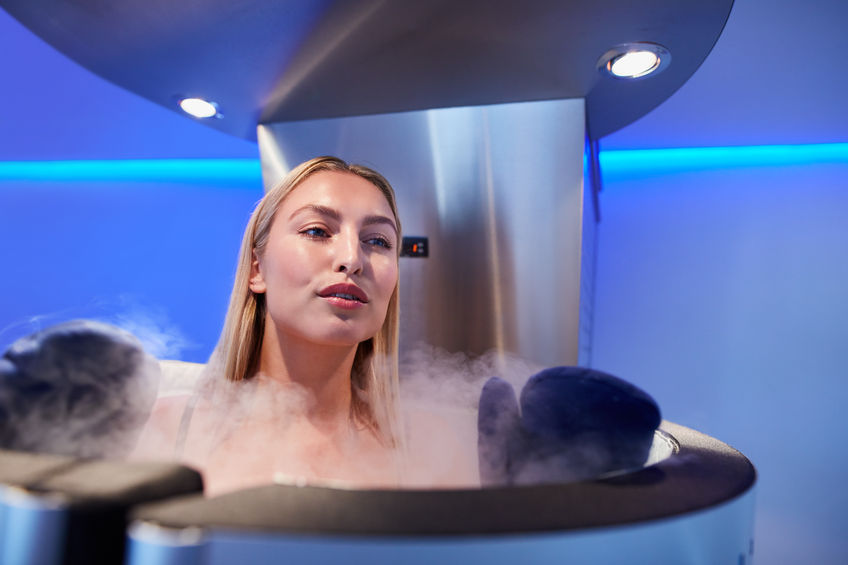With jargon like cryochambers and lots of dry ice, cryotherapy may remind you of something out of the middle ages.
But what is cryotherapy? It’s been hailed as everything from a weight-loss solution to an uber-recovery device for CrossFit athletes. Does it work? Is it safe?
What is Cryotherapy?
To begin, let’s figure out exactly what cryotherapy actually is.
 Whole body cryotherapy, also referred to as WBC, is submerging the body in sub-zero temperatures, usually in some sort of full-body chamber, to stimulate the nervous system. These chambers are kept at temperatures below -200 degrees Fahrenheit and participants are exposed for just a few minutes while wearing as little clothing as possible.
Whole body cryotherapy, also referred to as WBC, is submerging the body in sub-zero temperatures, usually in some sort of full-body chamber, to stimulate the nervous system. These chambers are kept at temperatures below -200 degrees Fahrenheit and participants are exposed for just a few minutes while wearing as little clothing as possible.Cryotherapy has become a trendy way to do everything from looking younger to losing weight — think along the lines of the acupuncture craze or the weight-loss wraps in years past. Spas hail them as the newest way to burn hundreds of calories in a single session. CrossFitters line up between WODs at competitions for a turn in the chamber to relieve their sore muscles. Sports teams are purchasing them for use in their locker rooms between innings or halves.
Does Cryotherapy Work?
Well, it depends on who you ask.
Cryotherapy has legitimate roots. It was developed in Japan in the 1970s and although it is currently taking the Western world by storm, it’s been a common practice used by many mainstream physicians to treat symptoms for diseases associated with inflammation such as arthritis and fibromyalgia.
Sound a little crazy? Whole-body cryotherapy is a relatively new phenomenon, but you’ve most likely used localized cryotherapy — or cold therapy — to treat symptoms of inflammation before. If you’ve ever dealt with swelling, a sprain or a sports injury, you know just how much relief a cold bag of ice can provide. Really serious athletes have sworn by ice-baths for decades. Whole-body cryotherapy is the same concept, but on a larger scale.
But its effectiveness has yet to be determined. No studies have been able to find any conclusive evidence that cryotherapy provides relief for battered muscles, injuries or anything of the like. This doesn’t necessarily mean there aren’t any — there aren’t many studies that examine cryotherapy as a therapeutical practice to begin with and more are needed before any conclusions can be drawn. However, anecdotal evidence shows cryotherapy in a good light — many athletes swear by the practice for recovery.
As far as weight loss and anti-aging effects, experts say the links are tenuous at best.
The good news for athletes is that there is also no evidence that cryotherapy is dangerous in any way, shape or form. According to this article published by the Sports Medicine Journal, whole-body cryotherapy does not cause any harmful chemical reactions or changes within the body during use, which brings us to our next point.
Is Cryotherapy Safe?
Again, it depends on who you ask.
In fact, WBC isn’t regulated by the Federal Drug Administration at all, meaning that anyone from doctors with multiple degrees to any old average Joe off the street can purchase and administrate the technology needed to conduct cryotherapy.
Sound scary? It should, since it can be fatal. Last year, a spa employee in Nevada was found dead after using the chamber unsupervised, prompting the state to issue regulations that stipulated all cryotherapy chambers had to be accompanied by defibrillators and to be trained in CPR.
Dangers posed from cryotherapy can include frostbite if you enter the chamber or sauna with wet clothing, overexposure, problems for people with circulatory problems such as those who suffer from diabetes, and ultimately freezing to death if the chamber is used incorrectly or without supervision.
Cryotherapy: Too Cool to be True?
If you ask athletes who use cryotherapy as a recovery tool, they’ll tell you good things. I’ve come across anecdotes that include everything from muscle recovery to energy and mood-boosts.
If you’re interested in giving cryotherapy a try, do some research and make sure your provider is using the technology safely and properly. Avoid cryotherapy as a weight-loss or anti-aging tool and instead focus on living a healthier lifestyle, avoiding natural aging agents like the sun and cigarettes and exercise regularly.
Have you tried cryotherapy? What was your experience? Let us know in the comments.
References
